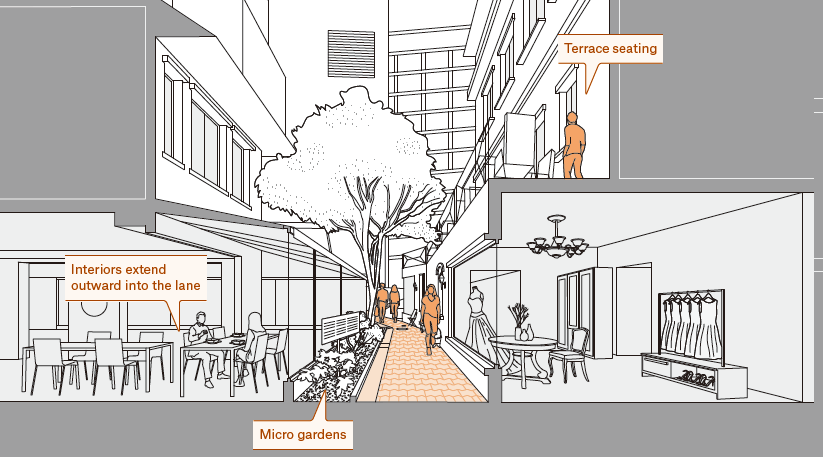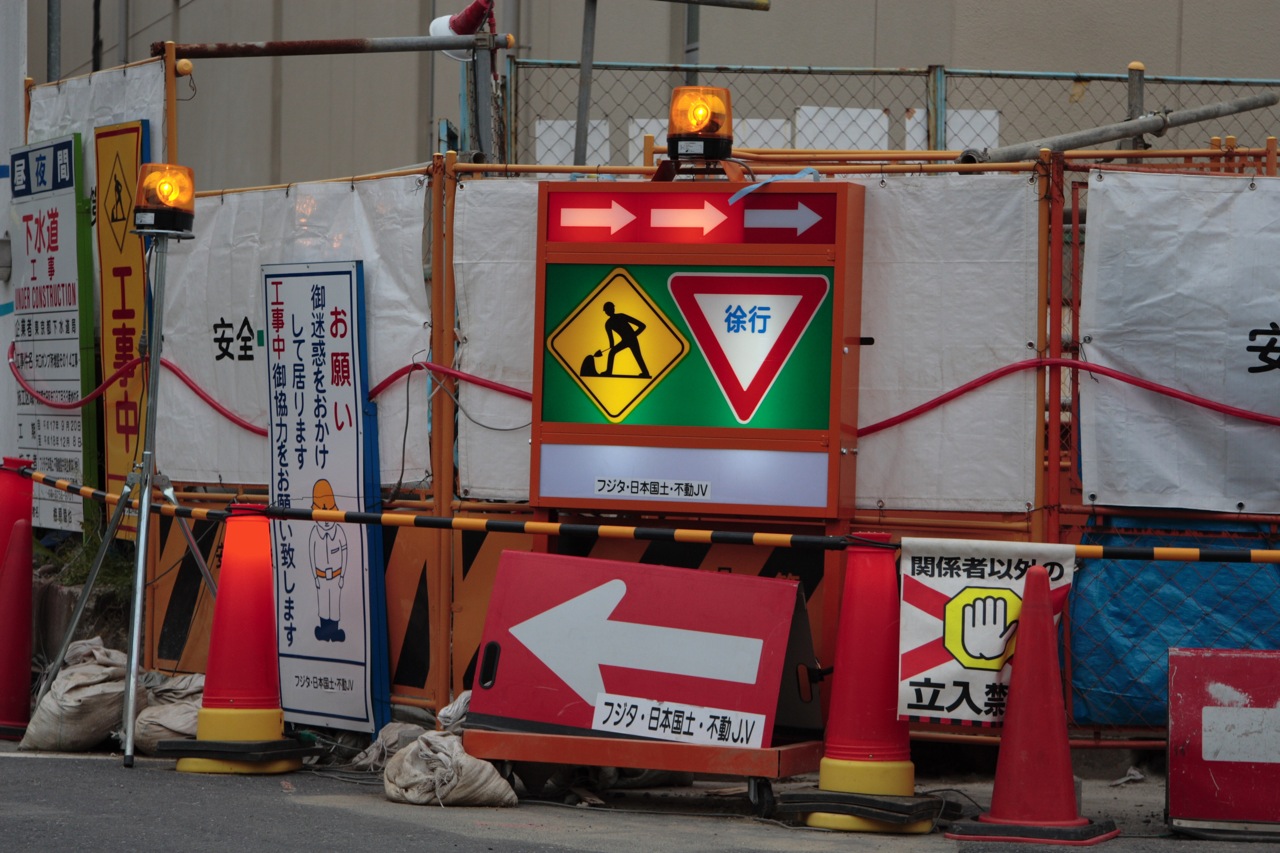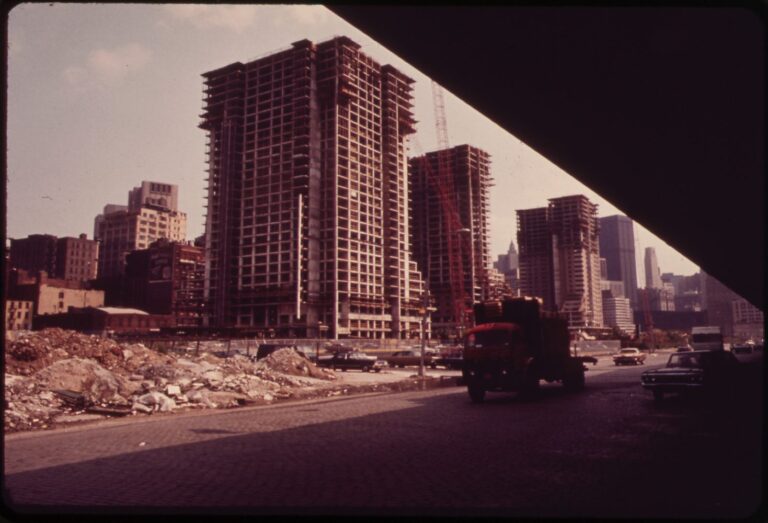Physical Address
304 North Cardinal St.
Dorchester Center, MA 02124
Physical Address
304 North Cardinal St.
Dorchester Center, MA 02124

For a reading group, I recently read two papers about the costs and (in)efficiencies around land assembly. One advocated nudging small landowners into land assembly; the other is an implicit caution against doing so. Graduated Density Zoning Although he’s mostly known for parking research and policy, Donald Shoup responded to the ugliness of eminent domain in Kelo v. City of New London, with a 2008 paper suggesting “graduated density zoning” as a milder alternative. Graduated density zoning would allow greater densities or higher height limits for larger parcels – so that holdouts would face greater risk. Samurai to Skyscrapers Junichi Yamasaki, Kentaro Nakajima, and Kensuke Teshima’s paper, From Samurai to Skyscrapers: How Transaction Costs Shape Tokyo, is a fascinating and technical account of how sweeping changes put the relative prices of different-sized lots on a roller-coaster from the 19th century to the present. First, large estates were mandated as a way for the shogun to keep nobles under his close control. Then, with the Meiji Restoration, the nobles were released to sell their land, swamping the market and depressing prices. The value of land in former estate areas stayed low into the 1950s. But with the advent of skyscrapers – which need large base areas – the old estate areas first matched and then exceeded neighboring small-lot areas in central Tokyo. A meta-lesson from this reversal is that “efficiency” is a time-bound concept. One can imagine a 1931 urban planner imposing a tight street grid and forcing lot subdivision to unlock value on the depressed side of the tracks. That didn’t happen; instead, the large lots were a land bank that allowed a skyscraper boom right near the heart of a very old city, helping propel the Japanese economy beyond middle-income status. We should take a long, uncertain view of […]
In his new book Arbitrary Lines, Nolan Gray points out that Tokyo is more affordable than many U.S. cities because its zoning policies are less restrictive. One common counterargument is that because Tokyo is a population-losing city in a population-losing city, it simply lacks the demand to have high housing prices, and is thus more comparable to the low-cost Rust Belt than to high-cost cities like New York. But a short look at my World Almanac suggests otherwise. On page 730, it lists the world’s largest urban areas. It shows that between 2000 and 2021 , Tokyo actually grew by 8.4 percent. By contrast, metropolitan New York-Newark grew by 5.7 percent, and Los Angeles by 5.6 percent. In other words, Tokyo’s population actually grew more rapidly than high-cost U.S. cities.

As foreigners, we are mesmerized by zakkyo buildings or yokocho, but within Japan, scholars, and authorities often ignore and neglect them as urban subproducts. In spite of their conspicuous presence and popularity, the official discourse still considers most of Emergent Tokyo as unsightly, dangerous, or underdeveloped. The book offers the Japanese readership a fresh view of their own everyday life environment as a valuable social, spatial, and even aesthetic legacy from which they could envision alternative futures.

American YIMBYs point to Tokyo as proof that nationalized zoning and a laissez faire building culture can protect affordability. But a great deal of that knowledge can be traced back to a classic 2014 Urban Kchoze blog post. As the YIMBY movement matures, it's time to go books deep into the fascinating details of Japan's land use institutions.

Over the past few years, Japanese zoning has become popular among YIMBYs thanks to a classic blog post by Urban kchoze. It’s easy to see why: Japanese zoning is relatively liberal, with few bulk and density controls, limited use segregation, and no regulatory distinction between apartments and single-family homes. Most development in Japan happens “as-of-right,” meaning that securing permits doesn’t require a lengthy review process. Taken as a whole, Japan’s zoning system makes it easy to build walkable, mixed-use neighborhoods, which is why cities like Tokyo are among the most affordable in the developed world. But praise for Japanese zoning skirts an important meta question: Why did U.S. zoning end up so much more restrictive than Japanese zoning? To frame the puzzle a different way, why did U.S. and Japanese land-use regulation—which both started off quite liberal—diverge so dramatically in terms of restrictiveness? I will suggest three factors; the first two set out the “why” for restrictive zoning and the third sets out the “how.” Any YIMBY efforts to liberalize cities in the long term must address these three factors. First, the U.S. privileges real estate as an investment where Japan does not, incentivizing voters to prohibit new supply with restrictive zoning. Second, most public services in the U.S. are administered at the local level, driving local residents to use exclusionary zoning to “preserve” public service quality. Third, the U.S. practice of near-total deference to local land-use planning and widespread use of discretionary permitting creates a system in which local special interests can capture zoning regulation and remake it around their interests. At the outset, why might Americans voters demand stricter zoning than their Japanese counterparts? One possibility is that they are trying to preserve the value of their only meaningful asset: their home. In the U.S., we use housing […]
One of the popular sports broadcasts I used to watch as a kid promised interviews with athletes that would bring them to you “up close and personal.” As I was once waiting in line to order coffee at one of my favorite local coffeehouses there were several people ahead of me. I followed the “barista” taking orders, with his dark-framed glasses, reddish beard, and slightly hurried manner. From a distance, in those few minutes I formed an expectation about his personality: Blasé and probably a bit curt; someone who really doesn’t want to be here. But when I came face-to-face with him and placed my order, I could feel his liveliness, warmth, and friendliness. My expectations needed revising. It’s the same with cities. From a distance, from an airplane or a photograph, we notice macro features and sweeping patterns that might form our first impressions. Noticing the layout of streets or the pattern of buildings from the air we might say something like “Oh, what an impressive skyline!” or “This place is a dump!” For instance, New York, London, Paris have distinct skylines. Approaching these cities from the air is thrilling as we spot the Empire State Building dominating Midtown Manhattan, Big Ben and Parliament along the Thames, or the Eiffel Tower standing counterpoint to la Defense. Tokyo’s on the other hand is a different story, but that difference is informative. Tokyo’s skyline is, at least to me, terribly underwhelming. Heavily bombed and burned during World War II and subject to devastating earthquakes throughout its history, Tokyo has few tall buildings compared to other major cities. Even as you drive in closer along the highway from Narita Airport the architecture for the most part remains boxy and drab. When you actually enter the central city, with the Sumida River winding […]

In a recent blog post, Julia Galef has generated a fairly comprehensive list of pro-housing arguments and counterarguments to those arguments. She gives the most detailed consideration to the “infinite demand” argument- in her words, “So even if SF adds a lot of additional housing, prices will still rise almost as quickly as they would have anyway, as long as demand to live here continues to soar. This view is mainly based on examples of other desirable cities, like New York or Singapore, which have built new housing at a faster rate than SF but nevertheless saw steep increases in price.” To which I respond: New York? Really? New York is only pro-housing when compared to San Francisco- which is a bit like saying Iran is a libertarian paradise compared to the Islamic State. In fact, New York has built housing at a glacial pace. Between 1960 and 1976, the number of new housing units completed per year ranged from just over 14,000 to over 60,000, and exceeded 20,000 in all but four years. In the almost forty years since 1976, the number of new units exceeded 20,000 in only four years (2006-10) and was above 14,000 for only ten years (1989, 2002, 2004-10, 2015). Meanwhile, demand for housing has increased: between 2006 and 2014 alone, the citywide renter population grew by 600,000. A better example of a “desirable city” would be a city where both the population and the housing supply is growing at a rapid rate- Raleigh, for example, or Las Vegas. These cities are much cheaper than New York or San Francisco.* Another example of a cheap, permissive city is Tokyo. But the post suggests Tokyo may not have grown as fast as American cities. In fact, Tokyo’s regional population grew by 17 percent since 1990- from 32.5 million […]
1. This week at Market Urbanism: Nolan Gray‘s second article at Market Urbanism: Return to Sender: Housing affordability and the shipping container non-solution the belief that these projects could address the growing affordability crisis hints at a profound misunderstanding of the nature of the problem and distracts policymakers from viable solutions. 2. Where’s Scott?: Scott Beyer is spending Friday in Mobile, AL, to celebrate Mardi Gras where it was invented. His article this week was at Forbes: Washington, DC Reformed Its Zoning Code; Now Time To Ditch The Height Limits The DC zoning code changes are a testament to this growing consensus favoring deregulation. If it can happen in America’s center of governance, it means similar zoning overhauls may be awaiting other cities. 3. At the Market Urbanism Facebook Group: Alex Tabarrok of Marginal Revolution‘s Quora response to “What do economists think about buying vs renting a house?” via Nolan Gray It’s Superbowl Weekend, and John Morris had coffee with Pittsburgh Post-Gazette columnist, Brian O’Neill to explain why he wants to ‘Tear down Heinz Field’ (Pittsburgh Steelers) Krishan Madan informed us that Cincinnati Built a Subway System 100 Years Ago–BUT NEVER USED IT Sandy Ikeda shared a Guardian piece on the role of cities in shaping musical genres Speaking of music, let’s all sing the “Monorail Song” with Nolan Gray 4. Elsewhere: Alon Levy, Pedestrian Observations: Why Costs Matter Joe Cortwright at City Observatory: Don’t demonize driving—just stop subsidizing it Justin Fox: Why parking your car for free is actually expensive (h/t Donald Shoup) see this too Floating cities in Tokyo Bay?? (h/t Jeff Wood) RIP Bob Elliott: Bob and Ray on Urban Planning (h/t Michael Strong) Chicago may eliminate the Clybourn Planned Manufacturing District. A move Adam Hengels called for in 2014. 5. Stephen Smith‘s Tweet of the Week: SF & NYC’s experiences w/density bonuses/mandatory IZ suggest to […]

Wendell Cox has received his fair share of criticism from this blog, but his post last week about Tokyo’s surprising lack of density is very interesting. Sure, Tokyo’s suburbs are dense enough to be connected by job centers by rail, but the core is almost completely low- and lower-mid-rise, and thus not very dense: Tokyo does not have intensely dense central areas. The ku area [historic core] has a density of 37,300 per square mile (14,400 per square kilometer). This is well below the densities of Manhattan (69,000 & 27,000) and the ville de Paris (51,000 & 21,000). Only one of the ku (Toshima) exceeds the density of Paris. And then the suburbs themselves aren’t as compact as they could be: Further, according to the Japan House and Land Survey of 2008, Tokyo has a large stock of detached houses, by definition lower density. Nearly 45 percent of the Tokyo region’s housing is detached. One-third of the dwellings within 30 kilometers (18 miles) of the core are detached. This figure rises to more than 60 percent outside 30 kilometers from the core and 85 percent between 60 and 70 kilometers (37-43 kilometers) from the core (Figure 2). Some might see this as a validation of New Urbanism (which is sort of a bastardization of Old Urbanism), whose response to tall building enthusiasts like myself, Ed Glaeser, and Alon Levy is that “dense doesn’t have to mean tall.” And it’s true – Tokyo manages a relatively high density with very few tall buildings. But there are costs that Tokyo bears for its lack of height and downtown density. First and foremost are the high housing prices. Imagine New York City if Midtown and the Upper East and West Sides were still tenement neighborhoods, and everyone living and working above the sixth floor […]
Tyler Cowen of Marginal Revolution is in Japan, and is fascinated by the number of vending machines. He takes a minute to ponder on the economics of vending machines in Tokyo. First we must look to the shortage of storage space in homes. I suspect few Japanese want to buy big piles of stuff at Costco. So buy smaller “portions” and in the meantime the inventories are stored in the vending machines, where they are more or less at your disposal. I would also look at the storage space for humans in stores. Shops require expensive ground floor space. If you can eliminate the space the human takes up to manage the store and space shoppers use to enter and browse, you can store more compactly. It’s seems a little counterintuitive to think that the storage space could be more valuable than a human occupant… Bill’s comment led me to add this link to an automat in NYC: BAMN!